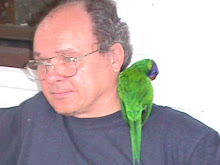 An in situ windrow, albeit less than 25% the size of the one removed to make space for the house
An in situ windrow, albeit less than 25% the size of the one removed to make space for the houseIn creating a space for the house we had to clear an extensive patch of land [with additional space to satisfy insurance requirements]; the clearing included a rather large “windrow” [trees bulldozed over and pushed together into a logpile]. Great habitat for the small skulkers! However, we not only left most windrows in situ, in felling an area of wattle shrubs [and they really are a fire hazard with amazing powers of regeneration] we also created a replacement windrow just north of the one cleared, albeit smaller and looser. It has since been colonized by a family of Variegated Fairy-wren.
The drought, a fact of life for most of the first decade of the 21st century, had a more adverse effect. As the ground dried, the understorey gradually disappeared and with it the undergrowth skulkers: the White-browed Scrubwrens, the Speckled Warblers, a host of thornbills, etc.
Some of course may have been no more than transitory to begin with – there when Fay and I first started our Allen Road list but already scheduled for a periodic migration to pastures new, elsewhere in the region. The Yellow-faced Honeyeater springs to mind. Back in 2001 the property seemed inundated with them but their numbers steadily declined until today [2010] their appearance raises an eyebrow. On the other hand, the Blue-faced Honeyeater, once a rarity here, has become numerous to the point of complacency.

On our return from the U.K. [www.staffordshirestray.blogspot.com] we knew that summer was fast approaching. The Sacred Kingfisher was there ahead of us; only the other day we finally tracked down a nesting pair on the southern boundary of the property – obviously they’ve either abandoned their former nesting haunts or this is a new pair setting up home in an available hollow.
The Channel-billed Cuckoo can be up as early of 0300 hours, its raucous call piercing the night’s silence. Dollarbirds flit and roll around the skies. The Australian [Eastern] Koel competes with both the cuckoo and the Laughing Kookaburra in seeing which can first shatter the peaceful tranquillity of slumbering humans. No bronze-cuckoos as yet but it’s still early days.

No comments:
Post a Comment